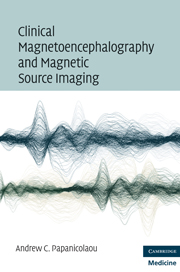Book contents
- Frontmatter
- Contents
- Contributors
- Preface
- Section 1 The method
- Section 2 Spontaneous brain activity
- Section 3 Evoked magnetic fields
- Postscript: Future applications of clinical MEG
- Overview
- Normal aging and neurodegenerative disorders
- Neurodevelopmental disorders
- Psychiatric disorders
- Neurological disorders
- Functional reorganization
- References
- Index
Neurological disorders
from Postscript: Future applications of clinical MEG
Published online by Cambridge University Press: 01 March 2010
- Frontmatter
- Contents
- Contributors
- Preface
- Section 1 The method
- Section 2 Spontaneous brain activity
- Section 3 Evoked magnetic fields
- Postscript: Future applications of clinical MEG
- Overview
- Normal aging and neurodegenerative disorders
- Neurodevelopmental disorders
- Psychiatric disorders
- Neurological disorders
- Functional reorganization
- References
- Index
Summary
Tinnitus
Among the neurological disorders which MEG has been used to address is tinnitus. An early MEG study of tinnitus by Hoke and coworkers used tonal stimulation to characterize the condition and demonstrated that the amplitude ratio of the M200/M100 components in these patients was abnormally small due to an augmented M100 response, though subsequent investigators were unable to replicate this finding using similar approaches. Abnormal modulation of these components has also been found during artificial inducement of tinnitus in normal controls using discotheque music. Emmerich and coworkers observed a transient delay and prolongation of the M100 component along with decreased conspicuity of the other auditory evoked field waveforms – including the M200 – in individuals exposed to musical stimulation relative to those unexposed.
In addition to differences in the amplitude of the classic auditory evoked field components, other researchers have approached the study of tinnitus through tonotopic mapping in the auditory cortex of these patients. Muhlnickel and coworkers found that the sources of auditory responses evoked by tones in the tinnitus frequency in patients were significantly shifted relative to source generators evoked by corresponding frequencies in neurologically intact controls. In addition, they found a strong association between the extent of cortical source shift and subjective strength of the tinnitus, suggesting that the condition may be characterized by abnormal neural plasticity of the auditory cortex. Applying the 40 Hz auditory steady-state response paradigm and using different carrier frequencies (384 to 6561 Hz), Wienbruch and colleagues reported that, relative to controls, patients with chronic tinnitus exhibited bilateral shifts in the location of auditory response sources within the primary auditory cortex.
- Type
- Chapter
- Information
- Clinical Magnetoencephalography and Magnetic Source Imaging , pp. 186 - 189Publisher: Cambridge University PressPrint publication year: 2009



